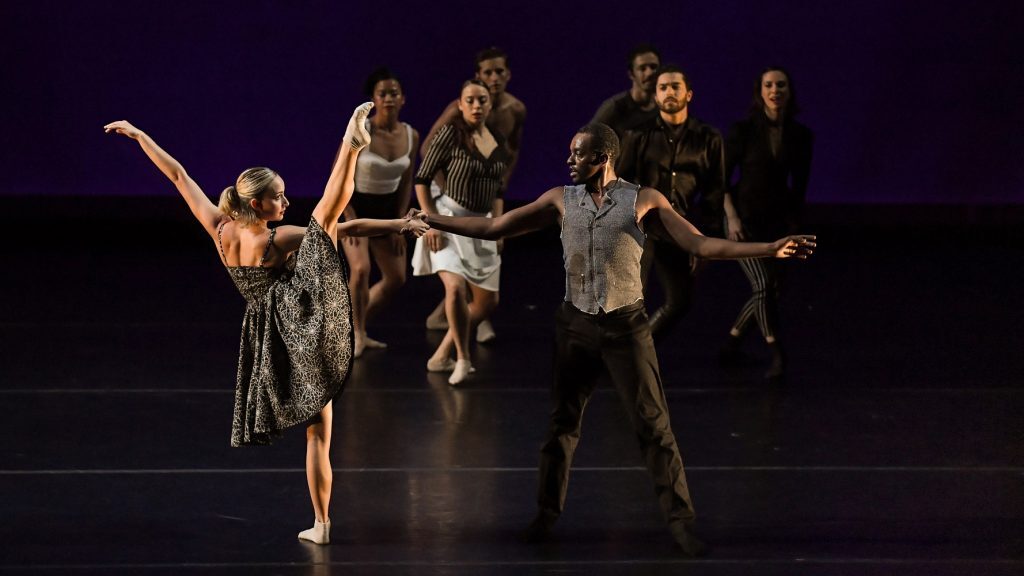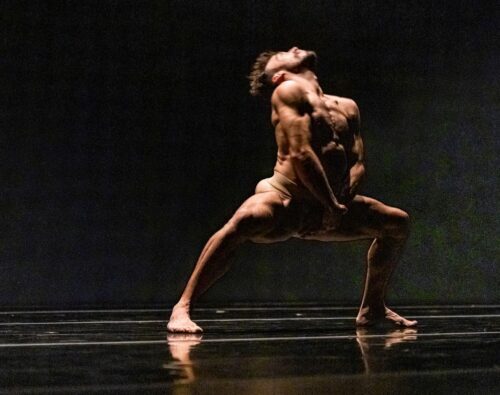Dancing To Our Humanity
Review of BODYTRAFFIC at Edmonds Center for the Arts
Written by Teen Writer Amelia Stiles and edited by Teen Editor Audrey Gray

An intertwined collaboration of classic styles and modern ideas drives compelling stories, as told by the dancers of the Los Angeles contemporary dance company, BODYTRAFFIC. The four-part program, presented at Edmonds Center for the Arts on October 26, uses aspects of mid-20th century music and dance to display BODYTRAFFIC’s style and technique while combining modern acting with inventive ideas. In this show of immensely imaginative pieces, the dancers use their bodies to tell emotional and innovative stories of human experiences. Although the impact of the storytelling fades as the final piece is performed, the company’s breath-taking technique is never absent.
Eight pairs of feet peek out from under the rising grand curtain, posed and placed evenly across the stage. Soon, the dancers turn into a gallery of silhouettes as the curtain disappears and the stage fills with light. The music of the famous 1940s jazz singer, Peggy Lee, opens the show’s first piece, A Million Voices. The dancers’ intricate and playful movements aptly convey the rhythmic quirkiness of jazz dance. Quick head turns, subtle heel raises and small articulations of their hands, paired with exaggerated facial expressions, give the piece a cheeky attitude. The upbeat music of Peggy Lee added excitement and peppiness to the dancers, with joyful sounds of a saxophone animating their high-energy motion. The dancers interact with each other in brief moments of tender romance with intimate lifts or quick swing duets. Comedic stories grasp my attention throughout, with water-filled wine glasses being dumped on the dancers by their fellow performers, avant-garde costumes inspired by ‘40s fashion, and theatrical expressions that create a lighthearted scene. The charming comedy soon shifts when the extravagantly dressed dancers clear the stage and one dancer remains. He repeats a locomotive action, moving his limbs in circles like wheels of a train but staying in one place onstage, as if he is stuck in the same movement. His repetitive actions soon turn harsh and rigid as he unexpectedly starts losing his balance and falling to the floor, the soulful lyrics of “The Freedom Train” by Peggy Lee amplifying throughout the theater. He personifies the train in the song, being held back by the obstacle of his own body. After the music ends, he continues this battle with himself in silence. Without the distraction of any music, the audience is pulled into his emotional battle, hearing every breath, fall, and footstep on the stage. It’s an almost uncomfortable experience—the audience has no choice but to endure his painful conflict with him. With the silence and the vulnerability of the solo dancer, I started questioning why the last ten minutes of cheeky jazz was paired with this distressing ending phase. The audience witnesses a moment of solitude where personal struggle and hardship is brought to the surface, directly after seeing a social scene where joy and love thrive. The piece captured how easily personal struggles can be hidden in the chaos of a community, compared to how someone can really struggle on their own.

I’m still pondering the end of the previous piece when the curtain rises for the next, Recurrence. Two dancers appear on stage, one dancer lying on the floor and the other sitting on his back. He supports her weight as they carefully and slowly rise together, a feat that keeps the audience’s focus locked in. The two dancers push and pull each other’s limbs, falling back and forth onto one another, carrying each other’s weight. Gestural movements like covering each other's eyes and mouths with their hands creates vulnerability and trust in the pair’s relationship. Accompanied by a track of sudden thundering and shattering noises, alongside moments of spoken word poetry about holding the weight of their partner, the pair continues this ongoing physical balancing act and looks pained and tired while trying to hold the other up. The depleted expressions of the dancers convey that as well as being physically distressed, they are also emotionally distressed. They pant and quickly gasp throughout the piece expressing their conflicting feelings for each other, allowing their vulnerability to take center stage. Through the pair’s ongoing physical balancing act, they symbolize the emotional balancing act of their relationship.
The show's third piece, SNAP, takes inspiration directly from the riveting and diverse streets of Los Angeles. The dancers pace the stage, quickly filling the space with motion, changing directions abruptly as if they are on a time crunch to be somewhere. They execute sharp, intense synchronized choreography repeatedly in different formations and places on the stage, portraying a group of workers living in a harshly routined environment. In the focused energy of the dancers, entering and exiting the stage with singular, concentrated paths, occasionally there are sudden moments when they burst out of sync. These bursts of individuality are paired with theatrical acting to contrast from the serious feeling of the rest of the dance. After several minutes of uniformity, the group of dancers suddenly lets go of all their refined, disciplined movement and breaks into liberating, high-energy hip hop. The dance turns into a scene of socializing and vocalizing, as the dancers cheer each other on and embrace their funky expressions of self. This block party-like scene paired with the joyous sounds of James Brown’s iconic lyrics, “I feel good,” enlivens the stage with a celebration of originality. The audience becomes vocal too, with hoots and hollers for the dancers' personalities coming to life. It gave me the urge to celebrate and have fun with them.

The final piece, PACOPEPEPLUTO, caused a dramatic shift of pace and rhythm, and a change in ambiance for the audience. Three male solos set to Dean Martin songs exemplify the dancers’ mastery of the precise technique of ballet and modern dance. The three soloists leap and turn through the air, with pointed feet and smiles on their faces. They each individually demand the stage with their grandiose, space-eating choreography. The dramatic side lighting accentuates the dancer’s silhouettes, highlighting their legs swinging above their heads. Although the earlier pieces sought to immerse the audiences into snippets of stories that conveyed motives of human interaction, this ending was an obvious appreciation for the solo dancers’ conventionally beautiful technique. Although moments of theatrical comedy snuck their way in, the solos didn’t portray much more than a piece for the audience to be impressed with the dancers’ physical abilities. After a show filled with intentionally imaginative and perplexing ideas, seeing a piece with little to no narrative or emotional motive was somewhat disrupting to the overall feeling of the show. This ending piece didn’t convey the same level of intention that the previous pieces did—I felt it failed to fit in with the focus of the show and obstructed the flow. I would have loved to see a more inspiring or purposeful story in this closing piece.
After four interesting and inventive pieces, I appreciated how much room for interpretation the viewer had. Discovering each piece’s motive was my favorite part of watching the performance. BODYTRAFFIC proves that storytelling through dance has endless possibilities. The narratives told through the four pieces highlighted the human body’s potential for expression of all sorts of innovative and abstract ideas, from silly and witty scenes to painful and passionate montages. To move an audience emotionally is just as important and impressive as the style and technique in a dance. BODYTRAFFIC exemplified a captivating way of doing all these things in just four pieces. Their performance that night reminded me of just how much dance is able to express emotionally compelling moments of the human condition.
BODYTRAFFIC took place at the Edmonds Center for the Arts on October 26, 2022. For more information see here.
Lead Photo: BODYTRAFFIC in SNAP choreographed by Micaela Taylor, performed at the Irvine Barclay Theatre. Photo by Kevin Parry
The TeenTix Newsroom is a group of teen writers led by the Teen Editorial Staff. For each review, Newsroom writers work individually with a teen editor to polish their writing for publication. The Teen Editorial Staff is made up of 6 teens who curate the review portion of the TeenTix blog. More information about the Teen Editorial Staff can be found HERE.
The TeenTix Press Corps promotes critical thinking, communication, and information literacy through criticism and journalism practice for teens. For more information about the Press Corps program see HERE.

